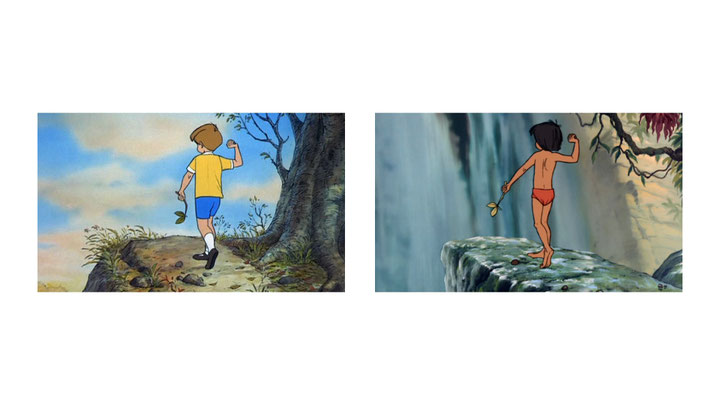However different Mowgli and Christopher may be, the protagonists of Rudyard Kipling’s The Jungle Book (1894) and Alan Alexander Milne’s Winnie-the-Pooh (1926) also have much in common. Ever since they were picked up by Walt Disney in the 1960s and reinterpreted as boys of a similar age and roughly the same height, the two have experienced adventures knitted from the same story-pattern together with an entourage of anthropomorphic animal figures. In fact, the animations even follow exactly the same pattern of movements: in frame after frame, the children’s book heroes scale one and the same slope at Disney. Mowgli climbs a rock in the middle of the jungle, Christopher a hill in the deciduous forest of North America. Mowgli throws nuts from the top of the rock he has just ascended; Christopher throws stones he finds amongst the roots of a gnarled tree. Even the movement sequences of the boys’ shocks of hair are identical, brown for the jungle child, blond for the bear’s friend.
“It takes two to make a thing go right,” a voice accompanies the concurrent and parallel mounted images of Mowgli and Christopher in Oliver Laric’s video Versions (2010). This video- and text-essay, shown in a range of variants by the Berlin-based artist on the Internet and in exhibition spaces, is an in-depth analysis of current copy culture. In his video, Laric, born in 1981 and thus part of a generation that views the Internet as self-evident, deals not only with phenomena debated against the backdrop of popular buzzwords such as copy-and-paste or the artistic production practice of the remix. Through the eclectic mixture of artwork, ranging from Greco-Roman sculpture via classic film, analogue as well as digital animation and 3D simulation, to comics, porn and, not least, memes, which circulate in endless loops on the net, the Versions artist reflects on the copy as a key component of contemporary artistic practice and, beyond that, as a part of everyday culture. The text narrated off-screen serves as a unifying element to the seemingly random visual material.
Whether the voice-over’s comments about Mowgli and Christopher in Oliver Laric’s video can be seen as an allusion to the 1988 hip-hop classic “It Takes Two” by Rob Base & DK E-Z Rock, or whether they actually reference a well-known saying is, on the one hand, a matter of interpretation dependent on recipients’ knowledge. On the other hand, however, the phrase’s origin is simply moot. “With famous books the first time is already the second, since we approach them already knowing them,” the voice in the video claims, continuing, “There is more work in interpreting interpretations than in interpreting things. And more books about books than any other subject.” Laric’s artistic point of departure is that, in the 21st century, original and copy are no longer concepts worthy of discussion. The ability to multiply and, just as easily, to disseminate text, image, tone and any other digital material with a single click of a mouse has made the copy standard practice; it is the new original.
“The original,” says art historian Wolfgang Ullrich, “is lacking in reality, even though we think it ought to be much more than any derivative image; dimensionally richer than a mere reproduction, in which numerous factors and sensory impressions cannot be reflected. But if, on the contrary, a copy looks better or is more poignant than the original, then it can indicate ontological saturnalia: what is otherwise only Secondary, the imitation that has, since Plato, been repeatedly undervalued, is now experienced as the Primary.” For Oliver Laric, the “location of the primary experience” of art also includes the Internet. On his pared-down website, pictures of installations appear alongside three different editions of the Versions video (2009, 2010 and 2012). In /i>Kopienkritik [Copy Critique] (2011) and CEO (2011), he continues his Internet-based research on the relationship between original and copy in real space.
For CEO at the major exhibition Based in Berlin Oliver Laric positioned three silver SUVs on the studio roof in the city’s Monbijoupark. According to the artist’s website, the striking similarity of the Chinese Shuanghuan cars to the X5 model by German manufacturer BMW prompted a Munich court to ban the sale of the imported vehicles in Germany on 26 June 2008. For the exhibition, Laric located a dealer who had registered some CEO models prior to the court ruling, which were thus protected by the so-called grandfather principle, with the owner retaining a guaranteed property right. By presenting these objects, rare in Germany, as “readymades” on the exhibition hall roof, the artist targets not only the obsolete boundary between original and copy, but also the mechanisms of global trade, which continue to support the old dichotomies. By exhibiting these rare copies and making them into unique objects, he turns the relationship between mass product and individual artefact on its head.
In Kopienkritik Laric deploys art history as a means to continue and develop what can be understood in CEO as an intervention into an economic system. The collection of Greek and Roman casts at Skulpturhalle Basel served Laric as a starting point for his location specific installation. In art history, copy critique is the term used to designate an analytical method supposed to lead us to the description of lost Greek artefacts through the contemplation of Roman copies. Laric has grouped and rearranged the Basel collection of sculptures according to their similarities of height, implied body movements and hand positions, using his own works as a foil. The projection of Versions can be seen on two female figures; monitors, which he simultaneously uses as pedestals for smaller sculptures in the collection, serve to display further video works. Lying scattered across the floor, the heads of Hercules and Hermes, produced with existing moulds from the collection, consort with their white predecessors like colourful ghosts. They are like spirits, whose subtlety is bred by history, a chronology that sees originals copied and the copies, in turn, become originals again in a sequence in which the gods’ heads, too, must actively find their place. Hermes and Hercules play out their roles as copies from the past, appearing in the present to shape current reality: “It’s the real thing” (Coca-Cola slogan, 1969/Versions 2010).
Translated by Katia Sand
1 Oliver Laric, Versions (2010), http://oliverlaric.com/vvversions.htm
2 Wolfgang Ullrich, Raffinierte Kunst. Übung vor Reproduktionen [Refined Art, Practice before Reproductions], Berlin 2009, p. 7.
3 Oliver Laric in an interview with Nora Malles in: Monopol – Magazin für Kunst und Leben, February 2011.



